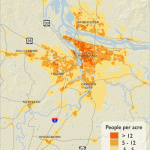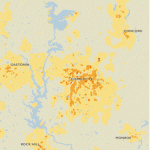Search Results
-
Is Sprawl Spendy?
This is less of a big deal than I had thought at first, but it’s still worth noting: new research (full pdf here) suggests that sprawl may be linked to higher home prices. The authors looked at housing prices in 452 urban areas across the US, along with measures of a couple dozen factors that can influence housing prices—including urban form, but also education levels, weather, demographics, recent population influx,...Read more » -
King of Sprawl
Does sprawl kill? Looks like it. This study found that people who live in sprawling counties—places with low population densities and poorly connected street grids, and with rigid segregation between stores, businesses and residences—are more likely to die in a car crash. Apparently, living in the sort of place where you can’t get anywhere without a car makes you drive more. And people who drive more tend to crash more. ...Read more » -
Sprawling Alone
InBowling Alone, Robert Putnam argues that the decline of social capital in the United States can be attributed partly to urban form. In other words, according to Putnam, sprawl is at least partly to blame for the present derth of bowling leagues. But is it really? Putnam’s arguments (summarized at the end of Chapter 12) are threefold. “Sprawl takes time” and results in more time spent alone in a car...Read more » -
Lessons on Sprawl and Transit…from Los Angeles?
Well, from the LA Times, at least. The paper’s had a series of guest editorials about traffic, transit and urban planning—specifically, how sprawling, congested LA can get itself out of the fix it’s put itself into over the last 60 years or so. The LA area is surprisingly dense, but the population is spread out fairly uniformly over a large area—which makes it very hard to service the region cost-effectively...Read more » -
Sprawl Rebounds
One crude measure of sprawl is the share of new housing that is going into the central city, as compared to surburbs and outlying areas. On this measure, King County excelled in 2000 when the county’s Annual Growth Report revealed that fully 45 percent of permits to build new housing had been given for projects inside the city of Seattle. The city has 32 percent of the county’s population, so...Read more » -
Greater Portland Population Growth and Sprawl
Person for person in the last decade, new development in metropolitan Portland consumed less than half as much land as the average city in a 15-city study by Sightline Institute.Read more » -
Population Growth and Sprawl, Greater Charlotte, NC
Greater Charlotte, North Carolina was the most sprawling of the 15 cities studied in the Sightline report, The Portland Exception. More than 2 out of every 3 residents live in low-density sprawl.Read more » -
Sprawl League
We just posted a new Cascadia Scorecard report on sprawl trends. Find it here. The gist is that Oregon has done a good job of protecting rural land around Portland: it’s the best of eight similar cities on that score. It’s not as good at channeling growth into compact neighborhoods.Read more » -
Sprawl Gobbles Paychecks
The price of gasoline has again dipped below (US) $2 per gallon in most of Cascadia, though it’s still up about 40 cents from its January level. This increase has hit low-income drivers harder than anyone else, as the Wall Street Journal documented two days ago. (Subscription required, login, then search July 12 for Jeffrey Ball’s frontpage article “For Many Low-Income Workers, High Gasoline Prices Take a Toll.”) Jeffrey Ball...Read more » -
The Weight of Sprawl
University of British Columbia researcher Lawrence Frank has documented the sprawl-driving-obesity connection more rigorously than anyone else, with his massive new study of Atlanta. (Pdf of study here.) The gist: The more you drive and the less you walk—and the more sprawling your neighborhood—the more likely you are to be obese. Among other findings, as summarized by AP: How much time a person spent driving had a greater impact on...Read more »



